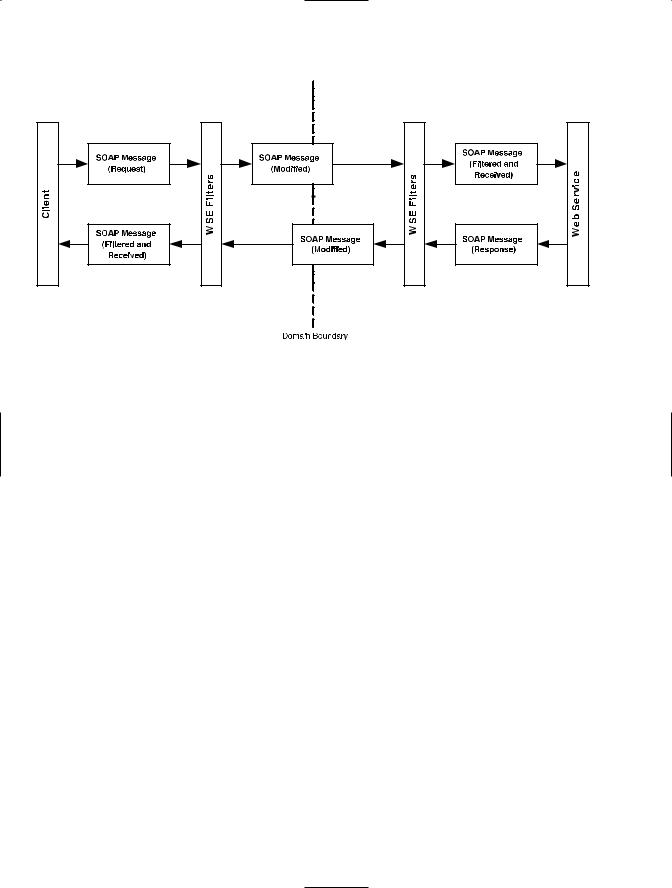
Expert Service-Oriented Architecture In CSharp 2005 (2006) [eng]
.pdf
86 C H A P T E R 5 ■ W E B S E R V I C E S E N H A N C E M E N T S 3 . 0
As you can see, each of the specifications is encapsulated within the SOAP header and each supports distinctive element tags so that no specification information can conflict. Web service composability is essential for allowing developers to choose which specifications are important for their Web services. In addition, this feature keeps message payloads smaller in size by not including element tags for unused specifications.
Introducing the WSSpecifications
Instead of simply listing the various WSspecifications, it is more useful to present them in the context of the framework’s goals. There are different perspectives on what the full set of goals are because the specifications are always evolving and are being drawn together by diverse coalitions of companies and organizations. But in our minds, there are six primary goals for the WSspecifications.
Interoperability
Web services must be able to communicate even if they are built on and operated on different platforms. Web service messages must use standard protocols and specifications that are broadly accepted, such as the WS-I Basic Profile, which includes XML, SOAP, and WSDL. Interoperability is the key to widespread acceptance of Web services for handling critical business processes.
Composability
This is a design principle that is fundamental to the WSspecifications. The term composability alludes to the fact that many of the WSspecifications are independent of each other and that a given Web service may not need to implement them all. For example, one Web service may require security but not reliable messaging. Another Web service may require transactions, but not policy. Composability allows a developer to implement only those specifications that are required. The WSspecifications support this because they are implemented as discrete sections within the SOAP message header (see Listing 5-1 for an example).
Security
Protocol-level security mechanisms such as HTTPS are currently in wide use, but they are designed for point-to-point security rather than message-oriented security, which is much more dynamic. The WS-Security specification is a message-oriented security solution that supports the dynamic nature of messages. With WS-Security, the security information is stored directly in the message header, so it stays with the message, even if the message gets routed to more than one endpoint. Messages must carry their security information with them so they can remain dynamic. The WS-Trust and WS-Secure Conversation specifications enable you to create a secure token service that procures security tokens for the duration of a specific conversation between a client and a Web service.

C H A P T E R 5 ■ W E B S E R V I C E S E N H A N C E M E N T S 3 . 0 |
87 |
Description and Discovery
Web services may be accessed from different clients across different domains. Web services must therefore be capable of publishing their metadata so that potential clients know how to call them. The WSDL document publishes supported types, operations, and port information. The WS-Policy specification documents and enforces usage requirements and preferences for a Web service. For example, WS-Policy will enforce that incoming SOAP requests must be signed and encrypted with digital certificates only, rather than any type of security token. The UDDI specification aims to provide a mechanism for clients to look up Web service metadata in a centralized directory.
Messaging and Delivery
The biggest vulnerability for a message besides security is the risk that it may never reach its intended destination—or worse, that not only does the message fail to reach the destination, but the sender is also unaware that it never arrived. You cannot correct a problem if you do not know it occurred. The WS-Reliable Messaging specification establishes a framework that is designed to keep all parties informed of where messages are and whether they arrived. This is critical in an architecture where a message may get routed between multiple endpoints. Failure at one endpoint should not bring down the entire workflow that the message is a part of.
Transactions
Transaction processing is a way of orchestrating multiple related business operations so that they succeed or fail together, and thereby preserve the integrity of the overall workflow. Transaction management is an extremely difficult challenge in an SOA. Web services are inherently disconnected stateless components that do not by nature participate in broadly distributed transactions. The WS-Coordination, WS-Atomic Transaction, and WS-Business Activity specifications are designed to address the challenge of implementing transactions across distributed Web services.
The WSSpecifications Covered in This Book
The WSspecifications will allow developers to build Web services that are interoperable, reliable, secure, and transacted. Ultimately, the overarching goal is for Web services technology to make it into the business mainstream and to be considered as good of a business solution as more established technologies.
This book does not cover all of the available WSspecifications for two reasons: First, it is impractical because some of the specifications are too new or too poorly established to be useful to most people. Second, it is problematic because WSE implements only a few of the available WSspecifications, albeit many of the most important ones.

88 C H A P T E R 5 ■ W E B S E R V I C E S E N H A N C E M E N T S 3 . 0
With these points in mind, here is a list of the WSspecifications we will be covering in this book:
•WS-Security
•WS-Policy
•WS-Secure Conversation
•WS-Addressing
•WS-Reliable Messaging
Perhaps the most glaring omission from the current WSE 3.0 is the absence of the transaction-related family of specifications, including WS-Coordination and WS-Atomic Transaction. But many other important specifications are present, most notably WS-Security, WS-Policy, and the WS-Addressing specifications. Omissions in WSE do not equate to insufficiency because it continues to evolve along with the WSspecifications themselves. WSE 3.0 will be subsumed in the future into the Windows Communication Foundation (WCF), formerly code-named Indigo, which will provide integrated support for message-oriented technology directly in the operating system, including greatly expanded infrastructure support. Many of the tasks that we must write complex code for today will become simpler in WCF. You can read more about WCF in Chapter 9.
Appendix A lists a number of useful references for learning more about the WSspecifications. Surprisingly, the original WSspecifications documents are highly readable and very informative. They do not, of course, cover any vendor-specific developer toolkit, such as WSE. But they provide clear definitions and explanations of the specifications, along with examples and references on how specifications are encoded within a SOAP message.
■Tip You can find links to the original WSspecifications documents at http://www-106.ibm.com/ developerworks/webservices/standards/.
One last thing to keep in mind is that just because a specification is absent from WSE does not mean that you cannot implement it yourself using custom code. The .NET Framework gives you support classes for working with XML, SOAP, and Web services, namely most of the core Web services technologies. In a sense, WSE provides you convenience, which you would like to have but can also live without if you have to. Developers already have a natural instinct to be self-motivated and to build custom solutions when nothing else is readily available.
We are not advocating that you find your own way to implement something that should be standard. In the absence of a canned solution, you still have the tools to build a credible alternative solution yourself. However, be prepared for considerable complexity!
In general, this book will remain focused on implementing solutions using the WSE support classes. But at times, we will show you ways to make up for deficiencies in WSE so that you can remain true to the spirit of the specification while using additional support

C H A P T E R 5 ■ W E B S E R V I C E S E N H A N C E M E N T S 3 . 0 |
89 |
technologies. As a .NET developer, you will find that the current version of WSE, along with a measure of creative thinking, will bring a heightened maturity to your Web services development efforts. WSE enables you to implement many of the features that a robust, business-oriented solution should include.
Welcome to the dynamic, evolving world of SOA with WSE.
Introducing Web Services Enhancements 3.0
WSE generally refers to both a software development toolkit and an add-on processing infrastructure for implementing the WSspecifications in .NET projects. From an infrastructure perspective, WSE is basically a processing engine for applying the WSspecifications to SOAP messages. As you have seen, WSspecifications are stamped across different parts of
a SOAP message. All of the WSspecifications append to the SOAP message header, while some of them also modify the SOAP message body directly (such as the WS-Security specifications). WSE automatically modifies SOAP messages to implement the WSspecifications. It also provides the infrastructure for processing these SOAP messages. In this sense it is similar to the ASP.NET Web services infrastructure, which provides SOAP and communications infrastructure support for the Web services you create using a friendlier API. Overall, the goal of WSE is to save developers from having to write custom code to implement basic required Web service infrastructure (such as security and policy).
WSE 3.0 is an SDK package for Microsoft .NET developers that includes the following:
The Microsoft.Web.Services3 assembly: This provides an API and includes several support classes, such as SOAP extensions and custom handlers.
Documentation and help files: These show you how to use and configure the WSE API and utilities.
QuickStart samples: These show you how to code with WSE.
Configuration Editor: This utility provides a GUI interface for configuring WSE in your
.NET projects.
X.509 Certificate Tool: This utility helps you work with X.509 digital certificates.
Policy Wizard: This utility provides a GUI for generating XML policy expression files (located inside the Configuration Editor).
How the WSE Processing Infrastructure Works
WSE installs a set of filters that intercept and process inbound and outbound SOAP request messages, as shown in Figure 5-1. The WSE filters work together inside a processing pipeline that also integrates with the ASP.NET processing pipeline. When a client application generates a SOAP request that includes WS enhancements, it specifies these in code using the API provided by WSE. When the message is sent out, it goes through a set of WSE filters that translate the code into SOAP extensions that are then applied directly to the SOAP message.

90 C H A P T E R 5 ■ W E B S E R V I C E S E N H A N C E M E N T S 3 . 0
Figure 5-1. WSE processing of SOAP messages
The WSE filters are dedicated to specific WSspecifications, or to groups of related specifications, including
•Security (including WS-Security)
•Policy (including WS-Policy and WS-Policy Attachments)
•Messaging (including WS-Addressing)
WSE is an extension to the existing ASP.NET framework and is dedicated to modifying and processing SOAP messages. WSE must be configured to work with a project. Even if it is installed on your machine, it will not automatically apply to your projects unless they are configured to use it. When you use WSE in a project, you register one of its assembly types as a SOAP extension class.
When you want to use WSE in a project, you must add a reference to the Microsoft.Web. Services3 project. You must also register the Web services configuration class in the project’s web.config file, as shown in Listing 5-2.
Listing 5-2. The WSE Configuration Class
<configuration xmlns="http://schemas.microsoft.com/.NetConfiguration/v2.0"> <configSections>
<section name="microsoft.web.services3" type="Microsoft.Web.Services3.Configuration.WebServicesConfiguration, Microsoft.Web.Services3, Version=3.0.0.0, Culture=neutral, PublicKeyToken=31bf3856ad364e35" />
</configSections>
</configuration>

C H A P T E R 5 ■ W E B S E R V I C E S E N H A N C E M E N T S 3 . 0 |
91 |
If the project is an ASP.NET Web service or application, you must also register the WSE SOAP extension classes in the web.config file, as shown in Listing 5-3.
Listing 5-3. The WSE SOAP Extension Type
<system.web>
<webServices>
< soapServerProtocolFactory type="Microsoft.Web.Services3.WseProtocolFactory,
Microsoft.Web.Services3, Version=3.0.0.0, Culture=neutral, PublicKeyToken=31bf3856ad364e35"/>
</soapServerProtocolFactory>
<soapExtensionImporterTypes>
<add type="Microsoft.Web.Services3.Description.WseExtensionImporter, Microsoft.Web.Services3, Version=3.0.0.0, Culture=neutral, PublicKeyToken=31bf3856ad364e35"/>
</soapExtensionImporterTypes>
</webServices>
</system.web>
This step instructs WSE to process the project’s SOAP messages through its filters. By default, WSE automatically applies all of its filters to SOAP messages. However, you can optimize the process by turning off selected filters. For example, if you do not implement routing and referral, you can turn off the related filters. This simply means that WSE will stop looking for these related elements when it processes incoming and outbound SOAP messages.
■Note WSE 3.0 ships with a utility called the Configuration Editor, which will automatically generate for you the configuration XML in Listing 5-2 and Listing 5-3. These listings are the same in every project, so you should not have to manually enter them. The Configuration Editor is reviewed later in this chapter in the section titled “Install and Configure WSE 3.0.”
How WSE Works with ASP.NET
WSE provides an API for applying WSspecifications to SOAP messages. The key player in the WSE class framework is the SoapContext class, which directly records the Web specification options and then later makes them available to the WSE filters for processing. The SoapContext class is a member of the Microsoft.Web.Services3 namespace and applies to
both request and response messages and provides you with a programmatic window to examine the contents of a SOAP message, including its envelope, header, and body contents. The SoapContext class is similar to the HTTPContext class, which encapsulates all HTTP-specific information about an individual HTTP request. Listing 5-4 shows you one example of using the SoapContext class to examine the security elements in a SOAP message.

92C H A P T E R 5 ■ W E B S E R V I C E S E N H A N C E M E N T S 3 . 0
Listing 5-4. Examining Message Security Elements Using the SoapContext Class
using Microsoft.Web.Services3;
using Microsoft.Web.Services3.Security;
using Microsoft.Web.Services3.Security.Tokens; SoapContext requestContext = RequestSoapContext.Current;
foreach (ISecurityElement objElem in requestContext.Security.Elements)
{
if (objElem is MessageSignature)
{
MessageSignature clientSignature = (MessageSignature)objElem;
if (clientSignature.SignatureToken is X509SecurityToken)
{
//Add code to process the X509SecurityToken
}
else if (clientSignature.SignatureToken is UsernameToken)
{
//Add code to process the UsernameToken
}
}
}
Table 5-1 provides a summary of important SoapContext class properties. Many of these properties provide access to specialized classes with their own nested API. For example, the Security property provides access to the SoapHeader class called Security, which provides support members for examining existing security information and for appending new security information to the SOAP message header.
Table 5-1. The SoapContext Class Properties
Property |
Description |
Addressing |
Provides access to the collection of WS-Addressing elements assigned to the |
|
SOAP message via the AddressingHeaders class. |
Envelope |
Provides direct access to the SOAP envelope via the SoapEnvelope class. This |
|
class provides several additional classes and properties that are useful for |
|
retrieving the contents of the SOAP envelope and body via classes and properties |
|
or directly as XML. |
IsInbound |
Indicates whether the SOAP message is incoming (true) or outbound (false). |
Referrals |
Provides the collection of referral elements assigned to the SOAP message via the |
|
ReferralsCollection class. |
Security |
Provides the security headers for the ultimate recipient of the SOAP message via |
|
the Security class. |
|
|

C H A P T E R 5 ■ W E B S E R V I C E S E N H A N C E M E N T S 3 . 0 |
93 |
As you look through the table, remember that the SoapContext class is always referenced in context, meaning that when you reference it in code, it will always be holding the contents of an active request or response message. By definition, there is no such thing as stand-alone or disconnected SoapContext. So it is useful to explore this class by setting a breakpoint in your code and examining the various member properties and their settings in the Immediate debug window. Also, the WSE 3.0 documentation contains a detailed class reference for the member classes. You can learn a lot about how WSE works by examining the various classes and properties and learning how they interact with each other.
The Microsoft.Web.Services3 assembly provides a large number of namespaces that cover several different WSspecifications. These are summarized in Table 5-2, along with a brief description of which WSspecifications they apply to. As you begin coding with the various WSspecifications, you will need to import one or more of these namespaces into your Web services project.
Table 5-2. Namespaces in WSE 3.0 Microsoft.Web.Services3 Assembly
Namespace |
Description |
(Root) |
Provides support classes for working with SOAP request and |
|
response messages, including the important SoapContext class. |
.Addressing |
Provides support for the WS-Addressing specification, which |
|
enables the SOAP message to contain its own addressing, |
|
destination, and routing information. |
.Configuration |
Provides support for processing the WSE configuration settings. |
.Configuration.Install |
Provides support functions to manage the installation of WSE. |
.Diagnostics |
Provides tracing support to log diagnostic information on a SOAP |
|
message before and after processing by the WSE filters. |
.Messaging |
Provides support for WS-Messaging, which enables you to process |
|
SOAP messages for transport with the HTTP or TCP protocols. |
|
The classes support SOAP formatting and serialization. |
.Messaging.Configuration |
Provides support for working with configuration elements that |
|
relate to the WS-Messaging specification. |
.Design |
Provides classes for processing policy expression files. |
.Referral |
Provides support for WS-Referral, which enables the routing of |
|
SOAP messages across multiple endpoints. |
.Security |
Provides support for WS-Security, including attaching security |
|
elements to SOAP messages and processing them. |
.Security.Configuration |
Provides support for working with configuration elements that |
|
relate to the WS-Security and WS-Secure Conversation |
|
specifications. |
.Security.Cryptography |
Provides support functions for processing cryptographic |
|
operations. |
.Security.Policy |
Provides support for the WS-Security Policy specification, which |
|
supports security-specific policy assertions. |
.Security.Tokens |
Indicates specialized classes for working with security tokens. |
Continued

94 C H A P T E R 5 ■ W E B S E R V I C E S E N H A N C E M E N T S 3 . 0
Table 5-2. Continued
Namespace |
Description |
.Security.Tokens.Kerberos |
Indicates specialized classes for working with security tokens that |
|
are associated with Kerberos tickets. |
.Security.X509 |
Indicates specialized classes for working with X.509 digital |
|
certificates. Note that this namespace provides utility |
|
classes for working with the classes in namespace |
|
.Security.Cryptography.X509Certificate.X509Certificate2. |
.Security.Utility |
Specifies generic classes for working with security-oriented |
|
properties, such as the creation and expiration time stamp |
|
information for a SOAP message. |
.Security.Xml |
Indicates specialized classes for working with XML signatures, |
|
which are an important support technology for digital signatures. |
.Xml |
Specifies general support classes for working with XML, |
|
particularly as it relates to the XML that is generated by the |
|
WSspecifications. These classes are used in conjunction |
|
with other XML classes in the .NET Framework. |
|
|
WSE provides programmatic hooks in the specifications that automatically generate the required SOAP elements for you, so you do not have to construct them manually. The WSE API is accessed differently by Web services vs. Web service clients. Let’s briefly look at the differences.
■Note With Visual Studio 2005, Web services can now be hosted under console applications through simple configuration entries in the application configuration file. This chapter focuses on Web services that are hosted under IIS, because it is currently a more common implementation scenario for .NET developers.
Web Service Access to the WSE API
Web services can access the SoapContext for either request or response SOAP messages using specialized classes called RequestSoapContext and ResponseSoapContext. These classes provide direct access to SOAP messages, and they support messages that are transported over different protocols, including the HTTP and TCP protocols. Each of the classes provides a static property called Current, which furnishes a reference to the SoapContext class.
For request messages, the SoapContext class is accessed using
SoapContext requestContext = RequestSoapContext.Current;
RequestSoapContext is a class provided by the WebServicesClientProtocol, and Current is a static property that returns the SoapContext class.
For response messages, the SoapContext class is accessed using
SoapContext responseContext = ResponseSoapContext.Current;

C H A P T E R 5 ■ W E B S E R V I C E S E N H A N C E M E N T S 3 . 0 |
95 |
Once the client references the SoapContext for the request message, it can reference or assign WSspecifications with the WSE API. For example, if the incoming request message requires digital signing with a certificate, the Web service can inspect the attached digital signatures using SoapContext (as shown previously in Listing 5-4). The Web service can also use SoapContext to modify outgoing response messages.
Unlike the service proxy class (described in the next section), the Web service itself does not need to derive from a specialized class in order to access the WSE functionality. However, you need to make sure the WSE support assemblies are correctly registered in the service’s web.config file.
■Note The SoapContext.Current static class creates a blocking risk because it interacts directly with the Web service context. For this reason, a Web service wrapper class (that invokes the Web service proxy) should never be created as a singleton; otherwise, multiple calls to the wrapper will result in blocked calls. Here is an example of what not to do:
Public Class webservicewrapper (singleton)
{
Private webserviceproxy _myProxy;
Public void dosomething
{
_myProxy.DoSomething();
}
}
Web Service Client Access to the WSE API
A Web service client interacts with a Web service via a proxy class. WSE provides a new base class for this proxy class to inherit from
Microsoft.Web.Services3.WebServicesClientProtocol
Without WSE installed, proxy class files inherit from
System.Web.Services.Protocols.SoapHttpClientProtocol
If WSE 3.0 is installed and a reference is set to Microsoft.Web.Services, two classes will be generated. One class will be derived from SoapHttpClientProtocol and will be named after the service (e.g., MyServiceClass). The second generated class will derive from WebServicesClientProtocol and will be named after the service name, with “WSE” appended to it (e.g., MyServiceClassWSE). The WebServicesClientProtocol class provides access to the SoapContext class for both request and response messages via the proxy class. Listing 5-5 shows an example of a Web client that is digitally signing a SOAP request message before sending it out to a service. The listing shows how you reference the SoapContext and then use it to assign the digital signature to the SOAP request message.
